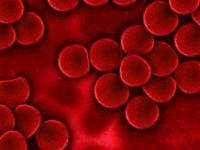Artificial blood – a project of a WUT team will help road traffic casualties and people awaiting a transplant
The team working on the development of blood substitute describe it as a milky-white odourless suspension and compare it to milk. Prof. Tomasz Ciach says jokingly that upon special request they will also produce blue blood. It is under his supervision that artificial blood was created at the Warsaw University of Technology. The team are in the process of refining the invention and they intend to patent it.
The invention mimics the most important function of blood consisting in carrying oxygen and carbon dioxide – the function for which erythrocytes are responsible. The diameter of natural blood cells is about 7 micrometres and of synthetic ones – 5 micrometres. "Natural blood cells are flattened, ours are spherical and that is why they have to be smaller to be able to pass through thin capillary veins", explains Prof. Ciach.
Special properties
There are also other aspects in which artificial blood cells differ from those produced by the body. They bind oxygen physically and not chemically but as gas carriers they are better than erythrocytes.
Moreover, there is no such thing as synthetic blood types and therefore, it is universal and may be given to each patient. It is prepared in sterile conditions which means that it does not have to undergo expensive tests, for example those that detect the presence of HIV. That kind of blood may be stored for very long periods of time unlike its natural equivalent. "From the chemical perspective, this is an artificial structure so no ageing processes are involved. Theoretically, it would be possible to store it forever but a decision regarding this matter has to be made by the relevant authorities", explains Prof. Ciach. Kamil Kopeć, a team member, adds: "This product can be lyophilised, meaning it can be dehydrated, kept in the fridge and mixed with sterile water just before use".
The WUT scientists’ invention has one more vital advantage – its administering does not breach the rules of religions which are against natural blood transfusion.
The beginnings of research
At the Laboratory of Biomedical Engineering work on blood has been going on for quite some time. It is here that thrombolytic coatings for the artificial heart developed by Prof. Zbigniew Religa as part of the project "Polish Artificial Heart" were produced.
Agata Stefanek carried out research into synthetic blood as part of her PhD thesis. The results she obtained were so good that a decision was made to continue her work. For this purpose, a spin-off called NanoSanguis was established. "The Warsaw University of Technology granted licence to the company and it is there that the technology is being developed", explains Prof. Ciach.
The team dealing with artificial blood is composed of 5 persons: Prof. Tomasz Ciach, Agata Stefanek, Kamil Kopeć, Magdalena Dresler and Joanna Graffstein.
To help but not to replace
The WUT scientists emphasise that their synthetic product is not supposed to replace natural blood. It is there to help road traffic casualties sustaining considerable blood loss. In such cases their blood volume is to be topped up (nowadays it is done using dextran solutions or saline) but sometimes that is not enough to ensure that oxygen is carried the usual way mainly to the brain. It is in such situations that the invention designed by the team from the Laboratory of Biochemical Engineering proves invaluable. "We want to support the remaining blood until the moment when the body starts producing new blood cells", says Kamil Kopeć.
WUT’s synthetic blood may also be used for the purposes of storing and transporting organs for transplant. This is a big problem as today the maximum length of time to deliver an organ to the recipient is about 6 hours. But thanks to Prof. Ciach’s invention it will be possible to store organs for transplant for longer periods of time and in conditions similar to physiological ones – at 37 degrees Celsius instead of using hypothermia as it is the case today. "Our blood is the basis, but to store and transport organs you also need other elements which will supply energy", emphasises Kamil Kopeć.
Combining science and business
The main challenge faced by this invention is the coexistence of natural and synthetic blood. It is therefore worth emphasising that artificial blood cells are meant to undergo biodegradation after several weeks when the body has already started producing new erythrocytes. Research is also conducted into reactions between artificial and normal blood cells and human cells. But that is not the end. "We are preparing big animal testing", says Prof. Ciach. But before they start we have to obtain a number of authorisations from the Bioethical Committee and that is likely to take some time.
"To market a medical product, you have to fulfil lots of formal requirements and conduct expensive research. We are looking at several millions of dollars here", says Prof. Ciach.
There are two kinds of activities carried out by the team developing artificial blood: scientific and business-related. The team are refining their product in the laboratory and applying for grants, looking form investors and preparing for the establishment of a company.
So far the WUT scientists have procured support from StartVenture@Poland and Giza Polish Ventures.
Agnieszka Kapela
Office for Promotion and Information








